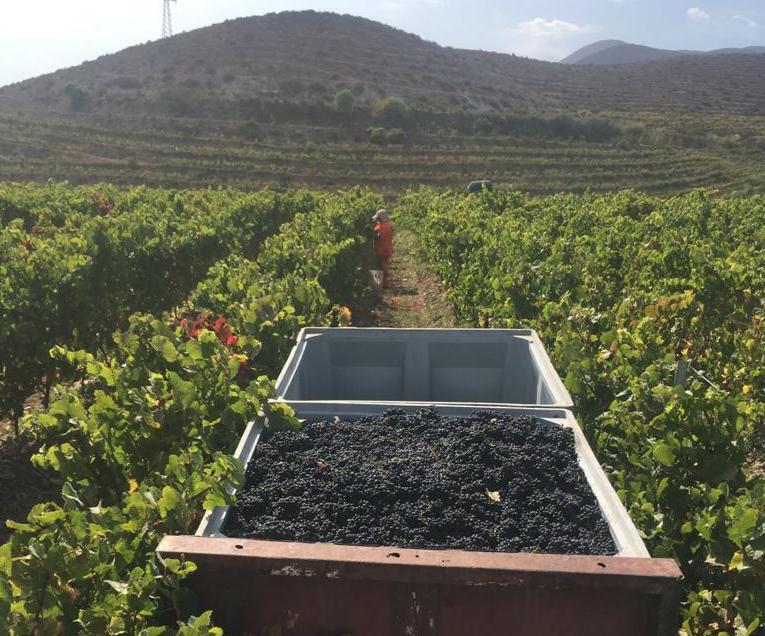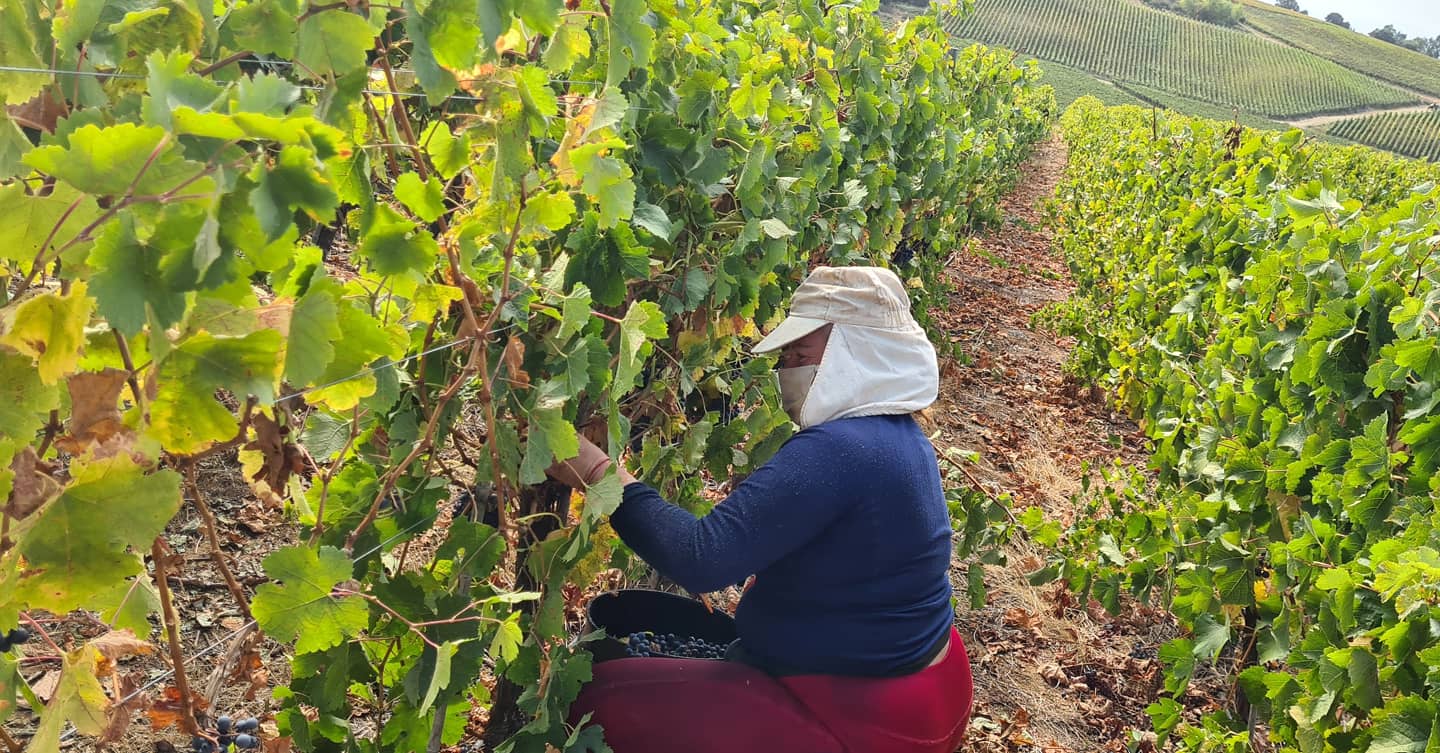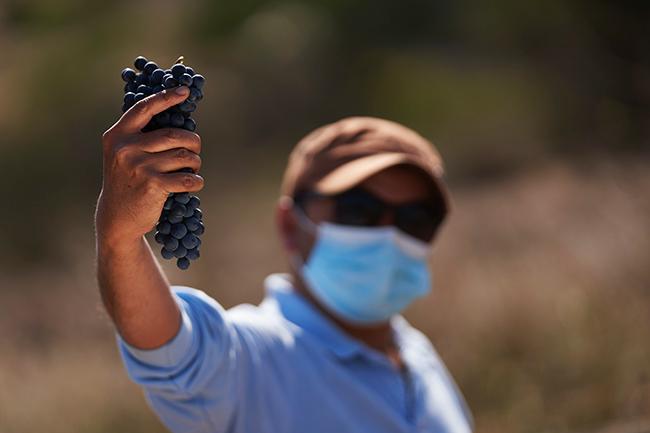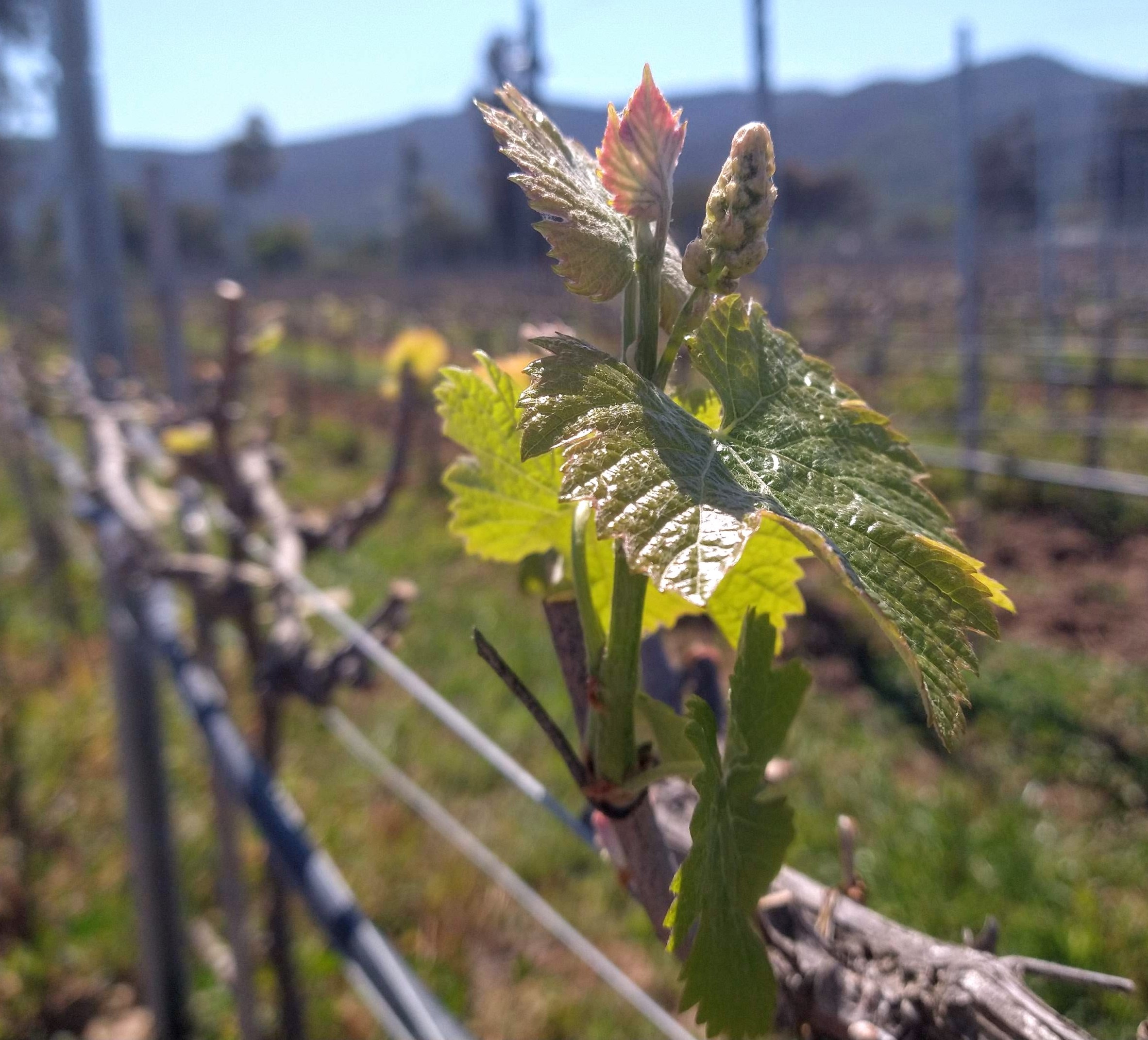As Chile’s harvest 2021 comes to a close, Helen J Conway reports on Chile Vintage 2021 and why some wine producers in Chile are heralding it as one of their best yet, while others are reporting challenges. This is our in-depth Chile vintage report 2021; check out our Chile vintage guide here.
Overview of Chile harvest 2021
2021 is overall a much fresher year with slow maturation which has offered some stellar quality in lower-yielding, quality-focused sites and should lead to wines of higher acidity, lower alcohol and good concentration. Much needed winter rain in the season helped with water supplies and gave a boost to the dry-farming regions, although some challenging summer rains would have led to a drop in quality for big volume, high-yielding crops.
Chile Vintage 2021 Report in detail
Winter 2020 brings relief in greater rainfall, snow and water reserves
Winter 2020 brought much-needed rain following the tremendously dry prior year – the worst in 60 years — when a state of agricultural emergency had to be declared for a large part of Chile, including all of the Central Valley, as wells and reservoirs ran dry. However, it wasn’t enough to overcome the drought that has been accruing since 2010. Miguel Torres Chile, for instance, noted 353% more rainfall than in 2019, but the 484mm they recorded in Curicó was still 30% less than the 20-year average of 701mm. With climate change forecasts of significant decreases in rainfall for the whole Central Valley, efficient water use has become top-of-mind for most Chilean wineries.
Nonetheless, in a nationwide survey carried out by the Chilean winemakers’ association (ANIAE), 92% of respondents reported that this season they have greater water reserves in the soil than in the previous year. This meant that the year got off to a good start, with budburst coming at the usual time.
In terms of temperatures, September was warm and October was variable and some areas – particularly Casablanca and Pirque – were hit by three consecutive nights of frost in October.
A cool summer with a wet start to February 2021
From November through to February, temperatures were lower than usual and the early part of November and the first two to three weeks of February were cloudy in many areas.
Between 28 January and 2 February 2021 rain fell in all regions between the Aconcagua and Osorno Valleys, which is highly unusual in mid-summer. It ranged from 10mm to over 100mm and the impact was very variable. In areas with less than 30mm, the rainfall tended to have a positive effect, particularly in the dry-farmed areas. In other areas, 100mm or more fell in just 48 hours and some areas even had hail. The worst-hit areas and vineyards with poorer draining soils or larger yields suffered from grape splitting, damage to clusters and canes, and an onset of bunch rot — compounded by cloudy weather in the following days.
However, for most of the quality-driven sites, swift action with canopy management techniques (leaf plucking, removing affected clusters, vineyard treatments) avoided any significant health issues.
Harvesting during times of Covid, again

The emergency lockdown measures that came into force during vintage 2020 were certainly a far greater shock than this year’s restrictions, but nevertheless, wineries had to prepare for certain challenges related to harvesting during the COVID-19 pandemic. First of all, with health restrictions in place, wineries had to reorganize the way in which they harvested and processed the grapes, organizing shifts and transport to and from work with maximum occupancy levels, checking workers’ temperatures every day and so on.
Secondly, it is common in the wine industry for people to gain experience working in wineries in other countries and so many Chilean wineries receive people from countries around the world. Needless to say, many of them left Chile in 2020 when the pandemic began to become serious and countries started closing their borders and, of course few foreign workers have arrived since.
Thirdly, wineries have been struggling for a few years to find sufficient people to perform vineyard tasks because fruit producers (cherries, blueberries etc) are able to attract rural workers with higher wages. The study carried out by the Chilean winemakers’ association revealed that up to 63% of those surveyed have had problems with workforce availability. This was somewhat resolved by redeploying tour guides and other hospitality and tourism staff to help out with other tasks in the vineyard and winery, as wine tourism has been limited since 2020.
Main photo by Matt Wilson
Chile Vintage Report 2021: Northern Chile
Huasco Vintage Report 2021
Lady Ramírez from Viña Armidita, an organic family producer located at altitude (1,100-1,800 masl) in the desert conditions of the Huasco Valley reports a great year for their wines, with yields 30-40% higher and stable growing conditions. She says that local legend holds that after a year with landslides due to the “Bolivian winter” phenomenon, such as occurred in January 2020, when 7 hectares of Armidita’s vines were swept away, the area has had a stable year. Rainfall was back to its usual level (0-12mm a year), there were no frost events and daytime temperatures were stable. The year-round temperatures here are around 0˚C at night and up to 27˚C by day but the maximums were lower (20˚C -21˚C) throughout the process of fermentation in lagares, favouring especially concentrated wines.
Elqui Vintage Report 2021

Unlike much of the Central Valley, Elqui didn’t have any summer rains at the end of January/early February and the vintage was consistent with the average vintage calendar in the region. “The season has been good as always here in Elqui, with no rain at all during the summer but fortunately with enough water for irrigation,” says Giorgio Flessati of Viña Falernia, the fine wine pioneer of the region. “Our Chardonnay and Pinot Noir are looking really good so far, in particular.”
Rosario Fillol of Viñedos de Alcohuaz says that rain from the Bolivian winter helped replenish the reservoirs that provide irrigation water, and that their vintage looks really good this year with all their red Mediterranean varieties (including Syrah, Garnacha and Touriga Nacional) already picked and fermenting.
Limarí Vintage Report 2021
Viña Tabali, one of the leading producers in Limarí, is reporting an excellent vintage. “We can compare this vintage to the cooler 2018 vintage, and the wines that are already fermented and finished are looking fantastic — the balance and the acidity are marvellous,” says Tabalí winemaker Felipe Müller. “We didn’t have any of this summer rain which was a bit more complicated for the early-ripening grapes further south. This year we had to pick the grapes two weeks later because it was a much cooler year, as the ripening of the grapes was much slower and so the retention of the acids and natural flavours was very good this year.”
Video interview with Felipe Müller on vintage 2021 in Limarí
View this post on Instagram
Choapa Vintage Report 2021
Gonzalo Gálvez of Viña Choapa, in the Entrecordilleras area of the warm northerly region of Choapa also reports a great year. This is an area where most of the grapes grown go to Pisco production and those growers have had bumper crops but at Viña Choapa, they control yields to ensure quality. Meanwhile, lower than usual temperatures (25˚C -28˚C rather than 35˚C), mean slower ripening with better acidity retention and aromatic concentration. In fact, he thinks it may be their best year since they started producing wine in 2013.
Aconcagua Vintage Report 2021
In the Aconcagua Valley, Daniela Meruvia and Jorge Carranca of Viña La Joda in San Esteban say that the spring frost did not affect budburst but they were affected by the January rainfall and needed to act fast to treat the plants before botrytis could set in but so far all looks good. Daniela says “the 2021 vintage looks good with good acidity and we’re hoping for fresh, fun wines with good structure and length. A good year for those of us who look after our grapes.”
Chile Harvest Report 2021 Central Valley and coastal regions
Casablanca & San Antonio Vintage Report 2021
A three-day frost in October frost affected some parts of Casablanca and San Antonio, especially as the region is mainly planted with early-budding varieties. Angela Mochi of Attilio y Mochi reported that the Sauvignon Blanc, Cabernet Franc, Viognier and Pinot Noir were affected, with the Viognier taking the greatest hit with yields down around 40%. Meanwhile Alberto Guolo at Casas del Bosque said the Chardonnay and Pinot Noir yields at Casas del Bosque are around 30% to 40% lower due to the frost. Alberto explains that while the secondary, dormant buds, often emerge after the initial buds are frost-damaged, the clusters of grapes they produce tend not to ripen and so are best removed, as a form of green harvesting. He added that there are other indirect consequences of frost, such as uneven flowering period and irregular ripening.
Casablanca, Leyda and other coastal areas were somewhat affected by the January rain – for instance 30mm fell in Casablanca, while Leyda experienced 57mm. However, the impact was mitigated by coastal breezes, pool soils and canopy management. Harvesting was also later than usual with a generally cooler vintage on the coast. “This year the coastal areas have experienced a very cool climate vintage!” says Eduardo Jordán of Miguel Torres, who make Sauvignon Blanc in Casablanca. “Ripeness has been very slow, and you had to take care with the botrytis risk but the result is good. The wines are lower in alcohol this year too.”
Andes Vintage Report 2021: Maipo, Cachapoal, Colchagua
Maipo Andes
In Maipo Alto, the maturation of grapes was particularly slow with a cooler February and March, and yields are up on the average year. “I’m very optimistic about the quality this year, we have very good acidity,” explains Viña Carmen winemaker Emily Faulconer. “This year we have a very different balance – the wines are very fresh with lower alcohol. I think this is going to be a very good vintage and we have very interesting profiles of wine, it reminds me of 2018 in terms of quality and style. I think it’s going to be a very good year for Cabernet Sauvignon [from Maipo Andes].”
With the poor soils in the higher vineyards, the rains also weren’t a problem in low-yielding vineyards but did slow down the season, as Emily explains: “The summer rain here in Maipo [Andes] wasn’t a problem in high-quality vineyards that aren’t overcropped; it just replaced an irrigation effectively. But what it did do was slow things down, and the end of ripening has been very slow because after the rain we had very cold temperatures for this time of year too. The vintage has been very slow… and very long!” Last year, in vintage 2020 most vineyards in Maipo Andes were picked by the end of March whereas this year harvest continued into April.
Video interview with Emily Faulconer on vintage 2021 in Maipo Andes
View this post on Instagram
Cachapoal Andes
Emiliano Domínguez from Calyptra in Alto Cachapoal says that although the rain in late January was heavy at Calyptra, botrytis was not a problem as the ground is free-draining and afternoon winds give good air circulation. An unusually cold early February was followed by a very warm late February, aiding ripening, although it is a later harvest than usual. So far the quality looks good with fresher wines than usual.
Colchagua Andes
Cristóbal Undurraga at Viña Koyle in Alto Colchagua is also predicting a fresh vintage with optimal balance and 25% more yield than last year. “Following two warm vintages, this year is a cool one, comparable with 2011 and 2016,” he says. “February has been cool following the 50mm of rain that fell on 29 January, marshalling in 20 days of cool, cloudy days, extending veraison. The result is crunchy acidity and balanced flavours.”
Entrecordilleras Vintage Report 2021: Maipo, Cachapoal, Colchagua
The entrecordillera areas in the Central Valleys received significant rainfall in January with different areas registering between 50mm and even 110 mm in San Javier in Maule. In a few locations there was also hail. The impact varied significantly between producers.
Maipo Entrecordilleras
Marco Antonio De Martino from Viña de Martino in Isla de Maipo reports that so far the vintage looks good in terms of quality, especially in the Cabernet Sauvignon and Malbec, which were positively impacted by the rain in late January and the cool weather of February, with ripe fruit and tannins, moderate potential alcohol and fresh acidity – all in all, extraordinary quality. “If we were in the Douro, we’d be calling this a vintage year,” he said.
Rafael Urrejola at Viña Undurraga in Maipo says, “concern about potential fungal problems following the rainfall meant we harvested earlier, so this will result in fresher wines and the grapes coming into the winery are showing good balance.
The Cabernet Sauvignon grapes are healthy and have been favoured by the cooler weather so we have high expectations of the Cabernet from Maipo and the reds in general. The Syrah may be a little affected by botrytis but we will try to avoid this through good viticultural management.”
Cachapoal Entre Cordilleras
Cristián Vallejo at Viña Vik in the Cachapoal Valley reports that it has been a year with moderate temperatures – autumn and spring were not too cool and summer was moderate and so the thermal variation was not great. He adds that they were well-placed to deal with the rain as they always ensure the vines are well-ventilated. All-in-all, he says they are expecting “spectacular-tasting wines”.
Colchagua Entre Cordilleras
Elina Carbonell at Vinos Lugarejo, Colchagua’s smallest winery, explained their vineyards escaped the frost and they were able to dry their clusters of grapes after the January rain, so they remained very healthy and free from botrytis. The cool weather means the grapes are ripening later than they have over the last 7 years and so the quality is looking good. However, because of the pandemic, the friends and family who normally come to help pick the grapes won’t be there. Elina says, “just like last year, this harvest will be lonelier and quieter but with the same energy and passion that we always put into producing Vinos Lugarejo.”
Curicó Entrecordilleras
“The yields of the whites is down by around 30% with good acidity and alcohol levels lower than last year, mostly because the harvest was brought forward because of the concern about botrytis,” explains Manuela Astaburuaga at Viña Correa Albano in Curicó. “There were problems due to the rain but less than expected. We are just getting underway with harvesting the reds and it’s too early to predict yields but we think they will be slightly higher, with good ripeness and acidity.”

Chile Harvest Report 2021: Interior Secano & dry-farmed areas of Maule, Itata, Biobio and Malleco
Producers in the dry-farmed areas known as Secano Interior are predicting a particularly good year.
“This is the season for finesse — it’s very specific the area and production,” summed up Eduardo Jordán of Miguel Torres, who works with growers and their own vineyards in the dry-farmed regions of Maule, Itata and Biobio. “There are definitely some winners and some losers — even within the same valley. For example, I think some of the winners are those who are dry farming in the Maule Valley, because in the last two seasons it was very dry and hot and the quality wasn’t the best, but this year the rains really helped these vineyards as the ripeness has been very slow and balanced. This year it really depends on where you are… the vineyards on the slopes in particular have some great quality this year, whereas the valley floor might struggle a bit more. Our dry-farmed vineyards on the steep schist slopes in Empedrado, Maule, are looking fantastic, for example.”
Video interview with Eduardo Jordán, Miguel Torres on Vintage 2021
View this post on Instagram
Wine consultant Fernando Almeda, who has a small vineyard in Maule, adds that by March the dry-farmed, bush-trained vines are normally stressed and very brown for lack of water but the January rainfall this year was a blessing for the vines, which lapped up the water and have more vegetation than normal. Furthermore, the most common varieties grown here are Carignan and País, rustic red varieties that don’t suffer too much from botrytis. Then February was cooler than usual, slowing ripening, meaning that producers are anticipating a vintage with good acidity, concentration and moderate alcohol.
Early signs of botrytis in Itata meant that many producers harvested earlier than normal this year, according to Fernando, who says that this earlier harvesting would also make for fresher wines — especially in Cinsault.
Daniella Gillmore of Gillmore Wines in Maule reports that the harvest is going really well so far, with the Semillon, Merlot and Carignan all harvested and the Cabernet Franc and the Italian varieties still to come. “So far, so good”, she says.
Austral Chile Vintage Report 2021
Miguel Torres Chile has one of Chile’s most southerly vineyards at 40° south, in the area of Rio Bueno, near to la Unión in the Osorno Valley. Eduardo Jordán reports that with the temperatures here dropping to 0°C, the precipitations of January fell as hail, damaging some clusters. However, the summer has been overall very warm and dry and the vintage looks promising.


